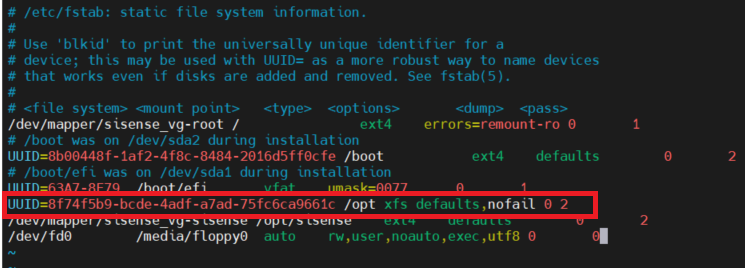Mounting on a Dedicated Disk for Sisense Single Nodes
Tier: Scale
Offering: On-Prem
For Sisense Linux deployments on a single node, you must mount the /opt or /opt/sisense directory on a dedicated disk. To mount an attached block device on every system reboot, add an entry for the device to the /etc/fstab file. You can use the device name, such as/dev/xvdf , in /etc/fstab , but Sisense recommends using the device's 128-bit universally unique identifier (UUID) instead. Device names can change, but the UUID persists throughout the lifetime of the partition. By using the UUID, you reduce the chances that the system becomes unbootable after a hardware reconfiguration.
Prerequisite: The device must exist on the Linux system and be ready for mounting.
To mount /opt:
-
Find the name of the device.
sudo lsblk -O
Example:
-
In the /dev directory, select the device to mount upon bootup as a Sisense storage and create a file system.
sudo mkfs.xfs /dev/{second_disk_name}
Example:sudo mkfs.xfs sda3Note:
If you need to resize the mount before mounting it, see Resizing and Mounting a Device for Installation.
-
Check that the
/optdirectory exists.ls -al /opt -
Find the UUID/ name of the device.
sudo lsblk -o +UUID
Example: -
Open the
/etc/fstabfile using any text editor.
Example:sudo vim /etc/fstab -
Add the following entry to
/etc/fstabto mount the device at the specified mount point. The fields are the UUID value returned by blkid (or lsblk for Ubuntu 18.04), the mount point, the file system, and the recommended file system mount options.UUID={second_disk_name} /opt xfs defaults,nofail 0 2
Example:
Note:
If you ever boot your instance without this volume attached (for example, after moving the volume to another instance), the nofail mount option enables the instance to boot even if there are errors mounting the volume. Debian derivatives, including Ubuntu versions earlier than 16.04 must also add the nobootwait mount option.
-
To verify that your entry works, run the following command to mount all file systems in
/etc/fstab. If there are no errors, your file system will mount automatically after it is rebooted.sudo mount -a -
Verify that the
/optdirectory is mounted to the new drive and is on the new disk.df -kh
Example:.png)
.PNG)
